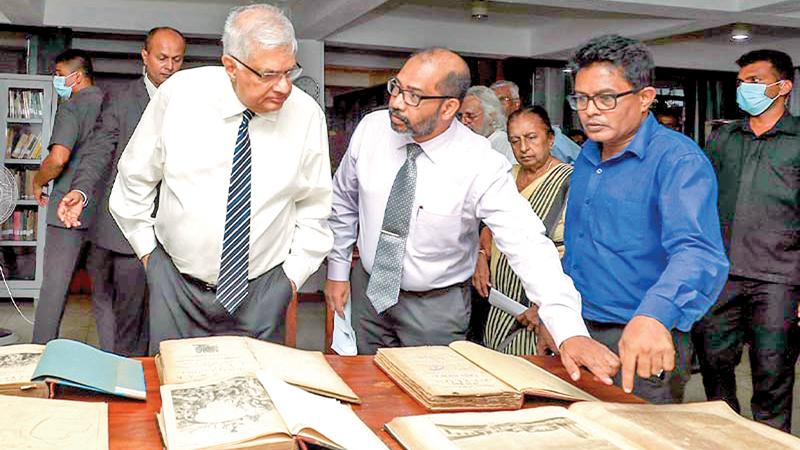
The Royal Asiatic Society of Sri Lanka is not just a platform limited to retrospect the relics of the bygone past. On the contrary, its existence from 1845 has widely galvanised serious research on the island’s history, culture, language and sciences from different perspectives.
Founded under the patronage of the British Colonial Government, the Royal Asiatic Society of Sri Lanka began to prosper as a branch of its counterpart in the UK.
Since its inception, the major administration of the Royal Asiatic Society was confined to senior British civil servants and judges who showed considerable interest in exploring the history of the island.
The influx of Sri Lankans to the top positions of the Royal Asiatic Society began in the early 20th century with the appointment of Sir Ponnamblam Aruncahalam as the president in 1916. The publication of the Journal of Royal Asiatic Society is an internationally reputed publication which has been publishing since 1854 and it holds a greater recognition among the orientalists, anthropologists and historians around the world.
This year marks the 178th anniversary of the Royal Asiatic Society of Sri Lanka, the oldest learned society in the country, but arguably the 178th year stands as a critical juncture for the society due to various reasons. Mainly the unlawful occupation of the Society’s premises by the Mahaweli Authority is a serious concern as it creates a vulnerability for the library of the Royal Asiatic Society which consists of an invaluable collection of books dating back to the 16th century.
Issues
 President Wickremesinghe at a discussion with the members of the Royal Asiatic Society
|
The deplorable financial status is another major problem for the continuity of the scholarly work of the Royal Asiatic Society. When its fellow Asiatic society in Calcutta receives Rs. 44 million from the central government of India monthly, the Royal Asiatic Society of Sri Lanka only receives Rs. one million annual grants from the Government, which is by all means not adequate for the main research of the society. Also, the lack of public awareness of the existence of the Royal Asiatic Society of Sri Lanka hinders its intellectual engagement with the public.
The gap between the Society and the University academia in Sri Lanka reflects the scholarly erosion of the country compared to the university scholars such as Prof. T. Nadaraja, and Prof. Ariyapala from yesteryears.
President Ranil Wickremesinghe visited the Royal Asiatic Society on April 27 against the backdrop of such crucial conditions that the Society has been facing. It was a response to an official letter by the current President of the Royal Asiatic Society Dr. Malini Dias to President Wickremesinghe regarding the troubled status of the Society.
The President’s visit is significant as it was the first visit made by the Head of the State of Sri Lanka since late President J.R Jayewardene, who visited the Royal Asiatic of Sri Lanka along with the British Prime Minister Margret Thatcher in 1985.
By the Constitution of the Royal Asiatic Society of Sri Lanka, the Head of State is the chief patron of the Society, which had been a practice upheld by the Colonial Governors. The visit of President Ranil Wickremesinghe is a gesture that stands along with that distinguished tradition.
President Wickremeshinge has a link with the Royal Asiatic Society rooted in his family history as the President’s grandfather C.L Wickremasinghe’s collection on the Sinhalese folklore remains in the library of the Royal Asiatic Society of Sri Lanka.
Yeoman service
The President at a discussion at the Royal Asiatic Society highlighted the yeoman service rendered by the distinguished scholars at the Society to preserve the historical studies of Sri Lanka.
He also highlighted how studying the history of Sri Lanka through “Mahawansa” enabled colonial archaeologists to trace the history of India as well.
The President was much concerned about the severe issues faced by the Royal Asiatic Society and pledged the support of the government to carry out future activities.
He said that the Royal Asiatic Society would play a pivotal role in initiating a new institute of history.
At a time when alacrity on history and social sciences withers away due to various reasons, the President’s interest in patronising the Royal Asiatic Society deserves to be admired.
Indeed, the rise of China and India as emerging global powers denotes the resurgence of Asian civilisational values as a counter-narrative for the Eurocentric hegemony and there is a steep interest in Western academia in studying the Global History of the Indian Ocean.
Writers such as Peter Frankopan and Sughatha Boss often write about the intrinsic values of South Asia and it is in this context that the role of the Royal Asiatic Society can become monumental in placing Lanka’s name in the global academia.
Thus, the visit by President Wickremesinghe will revitalise the Society’s activities.
The writer is the current Joint Secretary of the Royal Asiatic Society of Sri Lanka
